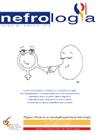POCUS超声:一种用于腹膜透析中检测和监测骨节减少症的工具
IF 2
4区 医学
Q2 UROLOGY & NEPHROLOGY
引用次数: 0
摘要
慢性肾脏疾病(CKD)患者中肌肉减少症的患病率在1.5%至68%之间。这种广泛的范围是由于不同的诊断工具和使用的截止点。早期诊断和干预肌肉减少症是必不可少的,因为它与较差的生活质量(QoL)、较高的住院率和不良事件有关。欧洲老年人肌肉减少症工作组(EWGSOP2)一致认为超声是一种量化肌肉质量的新兴工具。我们的目的是描述腹膜透析(PD)中肌少症风险的患病率和超声在我们的设置中的效用。材料和方法我们于2023年1月至10月在Puerta de Hierro大学医院对常见PD患者进行了一项观察性研究。收集临床、疗效、分析和营养参数,以及SPPB测量的功能表现、虚弱(虚弱量表)、营养不良风险(MIS量表)、生物阻抗和使用Lin’s公式估计的阑尾骨骼肌质量。超声测量肌上脂肪,轴(X和Y)和股四头肌的股直肌面积也包括在内,并根据身高和体表面积进行调整。我们根据EWGSOP2标准根据握力对肌肉减少症风险患者进行分类,并根据性别进行调整。本研究经耶罗门大学医院伦理委员会批准(第16/2023号)。结果38例患者,平均年龄65.4岁(SD 14.9),男性占65.8%。52.6%的患者瘦组织指数(LTI)降低,23.7%的患者脂肪组织指数(FTI)降低,平均相位角(AF)为4.5 (SD 1.1)。我们根据握力将42.1%的患者归类为有肌肉减少症风险的患者。他们年龄更大,有更多的合并症,根据MIS量表,营养状况更差,并且在虚弱和功能能力方面得分更低。同样,他们的LTI、下阑尾骨骼肌质量和下股四头肌厚度也较低(Y轴8.5 mm [SD 2.4]对11.8 mm [SD 3.3], P = 0.002)。肌少症患者的磷水平较低,c反应蛋白水平较高。超声对肌少症风险患者的预测能力为Y轴AUC为0.78(0.64-0.93),与生物阻抗的LTI和AF所得结果相似。结论PD患者肌少症发生率高,与患者年龄、合并症、营养不良和炎症有关。超声是一种易于获得、安全、低成本和易于使用的床边工具。这种方法有助于我们量化肌肉质量并评估其质量。鉴于股直肌(Y轴)的厚度与生物阻抗的良好相关性及其对肌少症风险的诊断价值,我们建议将其作为最佳补充参数。我们的经验将作为未来研究的基础,使我们能够定义PD的具体截止点,并设计监测和干预方案。本文章由计算机程序翻译,如有差异,请以英文原文为准。
Ecografía POCUS: una herramienta para la detección y seguimiento de sarcopenia en diálisis peritoneal
The prevalence of sarcopenia varies between 1.5% and 68% among patients with chronic kidney disease (CKD). This wide range is due to the different diagnostic tools and the cut-off points used. Early diagnosis and intervention of sarcopenia are essential because of its association with poorer quality of life (QoL), higher hospitalization rates, and adverse events. The European Working Group on Sarcopenia in Older People (EWGSOP2) consensus review suggests ultrasound as an emerging tool to quantify muscle mass. Our objective is to describe the prevalence of sarcopenia risk in peritoneal dialysis (PD) and the utility of ultrasound in our setting.
Material and methods
We conducted an observational study in prevalent PD patients at the Puerta de Hierro University Hospital between January and October 2023. Clinical, efficacy, analytical and nutritional parameters were collected, along with functional performance measured by SPPB, frailty (FRAIL scale), risk of malnutrition (MIS scale), bioimpedance and estimation of appendicular skeletal muscle mass using Lin's formula. Ultrasound measurement of supramuscular fat, axes (X and Y) and the area of the rectus femoris muscle of the quadriceps were also included, adjusted for height and body surface area. We classified patients at risk of sarcopenia based on handgrip strength according to EWGSOP2 criteria, adjusted for sex. This study was approved by the Ethics Committee of Puerta de Hierro University Hospital (No. 16/2023).
Results
We evaluated 38 patients, with a mean age of 65.4 years (SD 14.9), 65.8% were male. 52.6% had a reduced lean tissue index (LTI) and 23.7% had a reduced fat tissue index (FTI), with a mean phase angle (AF) of 4.5 (SD 1.1). We classified 42.1% as patients at risk of sarcopenia based on handgrip strength. They were older, had more comorbidities, poorer nutrition according to the MIS scale, and showed worse scores on frailty and functional capacity. Similary, they had a lower LTI, lower appendicular skeletal muscle mass, and lower quadriceps muscle thickness (Y axis 8.5 mm [SD 2.4] vs. 11.8 mm [SD 3.3], P = 0.002). Patients at risk of sarcopenic had lower phosphorus levels and higher C-reactive protein levels. The predictive capacity of ultrasound for classifying patients at risk of sarcopenia was AUC 0.78 (0.64-0.93) for Y axis, similar to those obtained with the LTI and AF of bioimpedance.
Conclusions
Sarcopenia risk is highly prevalent in PD and is related to age, comorbidity, malnutrition and inflammation in patients. Ultrasound is an accessible, safe, low-cost and easy-to-use tool at the bedside. This method helps us to quantify muscle mass and assess its quality. We propose the thickness of the rectus femoris muscle (Y axis) as the best complementary parameter given its good correlation with bioimpedance and its diagnostic value for sarcopenic risk. Our experience will serve as a basis for future studies that allow us to define specific cut-off points in PD and design monitoring and intervention protocols.
求助全文
通过发布文献求助,成功后即可免费获取论文全文。
去求助
来源期刊

Nefrologia
医学-泌尿学与肾脏学
CiteScore
3.40
自引率
7.70%
发文量
148
审稿时长
47 days
期刊介绍:
Nefrología is the official publication of the Spanish Society of Nephrology. The Journal publishes articles on basic or clinical research relating to nephrology, arterial hypertension, dialysis and kidney transplants. It is governed by the peer review system and all original papers are subject to internal assessment and external reviews. The journal accepts submissions of articles in English and in Spanish languages.
 求助内容:
求助内容: 应助结果提醒方式:
应助结果提醒方式:


